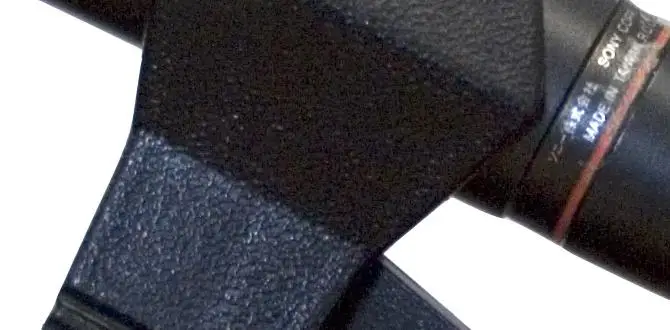Quick Summary:
Choosing a cheap TV panel type doesn’t mean settling for poor quality. This guide breaks down the most affordable TV display technologies like LED (LCD variants) and explores their pros and cons, helping you get the best picture for your budget. We’ll simplify the tech so you can make a confident purchase.
Buying a new TV can be exciting, but the sheer number of options and technical terms can quickly become overwhelming, especially when you’re trying to keep costs down. You’ve probably seen acronyms like LED, QLED, and OLED, and wondered what they actually mean for your viewing experience, and more importantly, your wallet. Don’t worry, you’re not alone! This guide is designed to cut through the confusion. We’ll explore the most common and affordable TV panel types, explaining them in simple terms so you can find a TV that looks great without breaking the bank. Get ready to understand the tech and make a smart choice.
Understanding TV Panel Types: What’s Inside Your Screen?
At the heart of your TV is the panel – the part that actually creates the image you see. Different panel technologies use different methods to light up and color pixels, and these differences dramatically affect picture quality, viewing angles, and, of course, price. For budget-conscious shoppers, the goal is to find the best balance of these factors. Most affordable TVs rely on variations of LCD (Liquid Crystal Display) technology, which has become incredibly efficient and cost-effective over the years.
While OLED panels offer superior contrast and true blacks, they are generally found in premium, more expensive televisions. For those looking for value, we’ll focus on the LCD family, which includes standard LED-backlit LCDs and their more advanced, but still budget-friendly, cousins. Let’s dive into the most common and accessible options.
The Reign of LED (LCD) TVs: Your Budget-Friendly Backbone
When we talk about “LED TVs” in the context of affordable options, we’re almost always referring to LCD TVs that use LEDs as their backlight. This is the most prevalent display technology in the market, especially in the budget and mid-range segments. They offer a great combination of brightness, color accuracy, and affordability.
How do LED (LCD) TVs Work?
An LCD TV screen is made up of a layer of liquid crystals sandwiched between two polarized filters and a backlight. Here’s a simple breakdown:
- Backlight: This is the light source behind the screen. In modern “LED” TVs, these LEDs are placed either along the edges (edge-lit) or directly behind the entire panel (direct-lit or full-array).
- Liquid Crystals: These crystals can twist and untwist when an electric current is applied. This twisting action controls how much light passes through them.
- Color Filters: Each pixel has a tiny red, green, or blue filter. As light passes through the liquid crystals and these filters, it forms the individual colors you see on screen.
The quality of the backlight and how it’s implemented significantly impacts the picture. Full-array backlighting is generally better than edge-lighting for black levels and uniformity, but edge-lit TVs can be thinner and cheaper to produce.
Pros and Cons of LED (LCD) TVs
LED TVs are popular for good reason, but like any technology, they have their strengths and weaknesses.
Advantages:
- Affordability: This is their biggest selling point. You can find excellent LED TVs at very competitive prices.
- Brightness: LED TVs can get very bright, making them excellent choices for well-lit rooms where ambient light can wash out darker screens.
- Wide Availability: They are everywhere! You’ll find a vast selection of sizes and brands.
- Good Lifespan: LEDs are durable and have a long operational life.
Disadvantages:
- Contrast Ratio: Compared to OLEDs, LEDs can struggle with true blacks and infinite contrast. Black areas might appear more like a dark gray, especially in darker viewing environments.
- Backlight Bleed/Uniformity Issues: Especially in cheaper models, you might notice uneven lighting, with brighter spots or light leaking from the edges.
- Viewing Angles: The picture quality can degrade (colors and contrast shift) when viewed from off-center angles.
Exploring Variations: VA vs. IPS Panels
Within the broader category of LCD technology, there are different types of liquid crystal alignments that affect picture quality. The two most common are VA (Vertical Alignment) and IPS (In-Plane Switching). While you might not always see these explicitly detailed on a budget TV’s spec sheet, understanding the difference can help you identify potential strengths.
VA Panels
VA panels are known for their superior contrast ratios and deeper blacks compared to IPS panels. They are a great choice if you watch a lot of movies or TV shows in a dimly lit room.
- Pros: Excellent contrast, deeper blacks, good for dark room viewing.
- Cons: Can have narrower viewing angles than IPS and sometimes suffer from “black smearing” where dark motion can look blurry.
IPS Panels
IPS panels excel in color accuracy and offer wider viewing angles. If you often have people watching the TV from different parts of the room or prioritize vibrant, accurate colors, an IPS panel might be more appealing.
- Pros: Wider viewing angles, excellent color accuracy, good for gaming and mixed-usage.
- Cons: Lower contrast ratios and blacks that aren’t as deep as VA panels.
For most budget TVs, manufacturers often lean towards VA panels to achieve better contrast, which is a highly noticeable picture quality improvement for many viewers. However, some budget brands might use IPS for broader appeal in well-lit spaces.
Beyond Basic LED: Quantum Dots and Mini-LEDs (Budget Considerations)
You might encounter terms like “QLED” (which is a type of LED TV) or “Mini-LED.” While these technologies often appear on mid-range to high-end TVs, some entry-level models are starting to incorporate aspects of them to offer better performance without a sky-high price tag. It’s good to know what they are, even if a truly cheap TV won’t have the most advanced versions.
Quantum Dot Technology (QLED – a type of LED)
When a TV is marketed as “QLED,” it typically means it’s an LED TV that uses a layer of quantum dots. These are tiny semiconductor particles that, when light shines through them, emit specific colors very efficiently. This results in brighter, more vibrant, and more accurate colors.
Budget Relevance: While high-end QLED TVs can be expensive, some entry-level LED TVs might use a simpler form of quantum dot enhancement to boost color performance. Don’t expect the full premium experience on a very cheap TV, but it’s an area where manufacturers are squeezing more out of LED technology.
Mini-LED Backlighting
Mini-LED is an advancement in how the backlight is arranged. Instead of larger LEDs, thousands of tiny LEDs are used, allowing for much finer control over dimming zones. This means deeper blacks and better contrast because sections of the screen can be dimmed or brightened independently.
Budget Relevance: Truly cheap TVs won’t feature Mini-LED. However, it’s worth noting that as this technology matures, we’ll likely see it trickle down into more affordable sets over time. For now, focus on standard LED backlighting in budget models.
The Price Factor: What Makes a TV Panel “Cheap”?
The cost of a TV panel is determined by several factors, including the complexity of the technology, the materials used, the manufacturing process, and the brand’s positioning in the market. For budget-friendly TVs, manufacturers prioritize cost-effectiveness.
Key Cost Drivers for Cheap TV Panels:
- Backlight Type: Edge-lit LED is generally cheaper to produce than full-array LED.
- Resolution: While 4K is becoming standard, older or very basic models might still be 1080p (Full HD) to save costs.
- Features: Lower refresh rates (e.g., 60Hz vs. 120Hz), fewer HDMI ports, lack of advanced smart features, and less robust smart TV platforms all contribute to a lower price.
- Panel Quality: Cheaper panels might use less expensive crystal materials or have less stringent quality control, leading to potential uniformity issues.
- Brand: Less established or budget-focused brands often compete on price.
Comparing Cheap TV Panel Types: A Quick Reference
To help you visualize the differences, here’s a simplified comparison of the most common panel types you’ll find in budget-friendly televisions:
| Panel Type | Typical Implication for Budget TVs | Best For Budget Buyers Who Prioritize | Potential Downsides on a Budget Set |
|---|---|---|---|
| Standard LED (Edge-Lit) | Most common, very affordable. Thinner design. | Overall best value, brightness for well-lit rooms. | Less uniform blacks, potential light bleed from edges. |
| Standard LED (Full-Array Direct-Lit) | Slightly more expensive than edge-lit, better picture control. | Better contrast and black levels for the price. | Can be slightly thicker, still not true blacks like OLED. |
| VA Panel LED | Often used in budget TVs for better contrast. | Good contrast for movie watching in less bright rooms. | Narrower viewing angles, potential motion blur. |
| IPS Panel LED | Less common in cheaper sets, but found sometimes. | Wider viewing angles, good for shared viewing. | Weaker contrast, blacks can look gray. |
It’s important to remember that “cheap” doesn’t always mean “bad.” Manufacturers are incredibly good at optimizing LED technology for acceptable performance at lower price points. When shopping, look for reviews that specifically mention picture quality in relation to the price. Resources like Rtings.com offer in-depth, objective reviews that can be invaluable, even for budget models.
Tips for Buying the Best Cheap TV Panel
Now that you understand the basics, here’s how to make sure you’re getting the most bang for your buck:
- Prioritize Picture Quality Over Bells and Whistles: On a budget, you’ll have to make trade-offs. Focus on a good panel and backlight system. Do you need the absolute fastest smart TV interface or are you happy with a USB stick for media?
- Read Reviews (and Look at the Right Ones): Don’t just rely on the star rating. Look for reviews that discuss contrast, black levels, motion handling, and input lag (if you’re a gamer). User reviews can highlight common issues like dead pixels or poor build quality.
- Check Refresh Rate: For most casual viewing, a 60Hz refresh rate is fine. If you watch a lot of sports or play video games, a 120Hz panel offers smoother motion, but these are usually found in more expensive TVs.
- Consider Size vs. Quality: It’s tempting to get the biggest screen possible for your money. However, sometimes a slightly smaller TV with a better quality panel will offer a more enjoyable viewing experience.
- Look for Local Dimming (on Full-Array TVs): If you find a full-array LED TV in your budget range, check if it has “local dimming.” This feature significantly improves contrast by dimming specific zones of the backlight.
- Don’t Chase Jargon: Terms like “HDR” are important, but on very cheap TVs, the implementation might be so basic that you won’t notice a huge difference. Focus on the core panel technology and backlight first.
- Understand Warranties and Return Policies: Buying budget electronics often means shorter or less comprehensive warranties. Know your retailer’s return policy in case of defects. For a deeper dive into display technology, you can explore resources from standards organizations like the International Display Consortium for industry insights.
Beyond LED: What About Other “Cheap” Technologies?
While this guide focuses on LED (LCD) as the dominant technology in the affordable TV market, it’s worth briefly mentioning other types that you might see glimpses of, though rarely as the primary cheap option.
Plasma TVs (Mostly Obsolete for New Purchases)
Plasma was once a strong competitor to LCD but is now largely out of production for consumer TVs. They offered excellent contrast and motion handling but were less bright than LEDs and could consume more power. You won’t find new plasma TVs in stores today, so this is more for historical context.
OLED TVs (Too Expensive for “Cheap”)
OLED (Organic Light Emitting Diode) panels are renowned for their perfect blacks, infinite contrast, and incredible viewing angles. Each pixel emits its own light, so they can be turned off completely for true black. However, the manufacturing costs for OLED are still significantly higher than for LCD, placing them firmly in the premium TV category. You won’t find a truly “cheap” OLED TV.
QLED vs. OLED (Quick Clarification)
It’s easy to get confused between QLED and OLED. Remember: QLED is a type of LED (LCD) TV that uses quantum dots to enhance color and brightness. OLED is an entirely different technology. For budget buyers, QLED will always be a variant of LED and thus more affordable than true OLED.
FAQ: Your Cheap TV Panel Questions Answered
Here are some common questions beginners have about affordable TV panel types:
Q1: What is the absolute cheapest type of TV panel technology?
A1: The cheapest TV panel technology available today is standard LED-backlit LCD. Within this category, edge-lit configurations are typically more affordable to produce than full-array backlighting.
Q2: Should I worry about “burn-in” on a cheap LED TV?
A2: Burn-in is primarily an issue for OLED and Plasma displays, where pixels can degrade over time if static images are displayed for very long periods. Modern LED (LCD) TVs are virtually immune to burn-in.
Q3: Is a 1080p TV still a good option if I’m on a very tight budget?
A3: For very small screen sizes (under 32 inches) or if you have extremely limited space and budget, a 1080p (Full HD) TV might still be an option. However, 4K is becoming so affordable that it’s often worth stretching your budget a little to get a 4K TV, especially for screen sizes 40 inches and larger, as it offers a sharper image.
Q4: What’s the difference between a “4K TV” and a “Smart TV”?
A4: 4K refers to the screen resolution (3840 x 2160 pixels), meaning a sharper, more detailed picture. A “Smart TV” has built-in internet connectivity and an operating system allowing you to stream content from apps like Netflix or YouTube. Many cheap TVs are now both 4K and Smart TVs.
Q5: How important is the “refresh rate” for a budget TV?
A5: For most viewers, a standard 60Hz refresh rate is perfectly adequate for watching movies, TV shows, and news. If you’re a serious gamer or watch a lot of fast-paced sports, a higher refresh rate (like 120Hz) makes motion look smoother, but these are usually found on more expensive TVs. For a budget TV, prioritize resolution and picture quality over refresh rate.
Q6: Are very cheap TVs worth buying, or should I save for a better one?
A6: Very cheap TVs can be great for secondary rooms, guest rooms, or for occasional use. However, they often compromise on picture quality, color accuracy, and long-term durability. If a TV is for your main viewing experience, it’s often worth saving a bit more for a mid-range model that offers a better balance of performance and price.
Conclusion: Making Your Smart, Budget-Friendly Choice
Navigating the world of TV panel types doesn’t have to be a headache, especially when you’re looking for a great value. As we’ve explored, the vast majority of affordable TVs rely on LED (LCD) technology, and for good reason. They offer a fantastic balance of brightness, color, and cost-effectiveness that’s hard to beat.
Whether you encounter an edge-lit or full-array LED, a VA or IPS panel, the key is to understand that these variations offer different strengths. For most budget shoppers, a good quality LED TV with decent contrast







